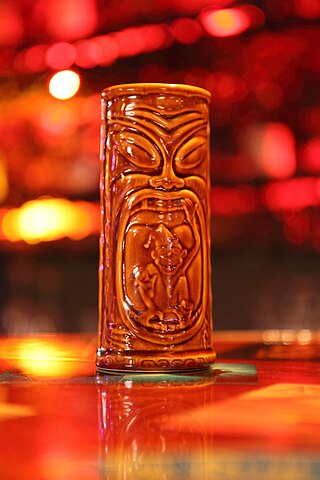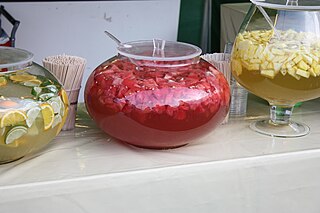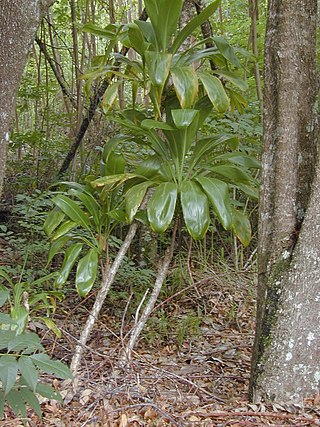Related Research Articles

Tiki culture is an American-originated art, music, and entertainment movement inspired by Polynesian, Melanesian, and Micronesian cultures, and by Oceanian art. Influential cultures to Tiki culture include Australasia, Melanesia, Micronesia, Polynesia, the Caribbean Islands, and Hawaii. The name comes from Tiki, the Māori name for the first human, often represented in the form of hei-tiki, a pendant and important taonga. The hei-tiki was often appropriated by Europeans as a commercialised good luck charm, hence the name of Tiki culture. Despite spanning over 10,000 miles and including many different unrelated cultures, religions, and languages, Tiki aesthetic is considered by some to be amalgamated into one "fantasia of trans-Pacific cultures" and "colonial nostalgia". Because of this, and the simplistic view of the Pacific taken by the aesthetic, Tiki culture has often proved controversial.

The Mai Tai is a cocktail made of rum, Curaçao liqueur, orgeat syrup, and lime juice. It is one of the characteristic cocktails in Tiki culture.

The Zombie is a Tiki cocktail made of fruit juices, liqueurs, and various rums. It first appeared in late 1934, invented by Donn Beach at his Hollywood Don the Beachcomber restaurant. It was popularized on the East coast soon afterwards at the 1939 New York World's Fair.
Donn Beach was an American adventurer, businessman, and World War II veteran who was the "founding father" of tiki culture. He is known for opening the first prototypical tiki bar, Don’s Beachcomber, during the 1930s in Hollywood, California, which was expanded to a chain of dozens of restaurants throughout the United States. He later built the International Market Place and additional establishments in what was then the Territory of Hawaii. He married three times.

The term punch refers to a wide assortment of drinks, both non-alcoholic and alcoholic, generally containing fruits or fruit juice. The drink was introduced from the Indian subcontinent to England by employees of the East India Company in the late 17th century. Punch is usually served at parties in large, wide bowls, known as punch bowls.

ʻŌkolehao is an alcoholic spirit whose main ingredient was the root of the ti plant. 'Ōkolehao's forerunner was a fermented ti root beverage or beer. When distillation techniques were introduced by English seamen in 1790, it was distilled into a highly alcoholic spirit.

A tiki mug is a large ceramic cocktail drinking vessel that originated in tiki bars and tropical-themed restaurants. The term "tiki mug" is a blanket term for the sculptural drinkware even though they vary in size and most do not contain handles. They typically depict Polynesian, mock-Polynesian, tropical, nautical, or retro themes, and as the term is used generically do not always emulate a tiki. When used to serve drinks they are frequently garnished with fruit or decorative drink umbrellas and swizzle sticks.

The Hurricane cocktail is a sweet alcoholic drink made with rum, lemon juice, and either passion fruit syrup or fassionola. It is one of many popular drinks served in New Orleans. It is traditionally served in the tall, curvy hurricane glass.

A tiki bar is a themed drinking establishment that serves elaborate cocktails, especially rum-based mixed drinks such as the Mai Tai and Zombie cocktails. Tiki bars are aesthetically defined by their tiki culture décor which is based upon a romanticized conception of tropical cultures, most commonly Polynesian. Some bars also incorporate general nautical themes or retro elements from the early atomic age.
A Scorpion Bowl is a communally shared alcoholic tiki drink served in a large ceramic bowl traditionally decorated with wahine or hula-girl island scenes and meant to be drunk through long straws. Bowl shapes and decorations can vary considerably. Starting off as a single-serve drink known as the Scorpion cocktail, its immense popularity as a bowl drink in tiki culture is attributed to Trader Vic.

The doctor cocktail is a pre-prohibition era cocktail that traces in drink guides to as far back as 1917, when it appeared in Hugo R. Ensslin's Recipes for Mixed Drinks. As originally described the cocktail called simply for Swedish Punsch mixed with lime juice.

The suffering bastard is the name for two different mixed drinks, one being more of a standard cocktail associated with World War II and the other being more of an exotic drink associated with Tiki bars. As is the case with many cocktails, there are multiple recipe variations and historical origins have been argued and changed over time. Two of the earliest recipe versions have very different ingredients. One from bartender Joe Scialom (1942) calls for brandy and gin, while another from Tiki pioneer Victor J. Bergeron primarily uses rum along with "secret ingredients" and is known for being garnished with a cucumber.
The Q.B. Cooler is a vintage tiki cocktail invented by Donn Beach that calls for a mixture of several rums, two syrups, fruit juices, and honey, mixed with club soda and dashes of Pernod, bitters, and grenadine. Another version purported to be from 1937 is slightly different and calls for varying rum proportions and ginger syrup in place of the fassionola and Pernod.
The Sumatra Kula is a vintage tiki cocktail invented by Donn Beach that calls for light rum, equal parts orange, lime and white grapefruit juices, and is sweetened with a diluted honey mix.
The test pilot cocktail is a vintage tiki drink invented by Donn Beach. Beach was known for changing his recipes over time, and multiple versions of the test pilot attributed to both him and others make the cocktail one of his more frequently imitated and varied tiki drinks. Test pilot recipes call for multiple rums and typically include the use of falernum syrup and lime juice. The more popular also include Pernod (pastis/absinthe) and bitters.
The cobra's fang is a vintage tiki cocktail invented by Donn Beach that calls for a mixture of rums along with fassionola and falernum syrups, the juice of orange and limes, and a dash each of bitters and grenadine. The recipe from the book Hawai'i: Tropical Rum Drinks & Cuisine By Don the Beachcomber calls for it being garnished with fresh mint and a lime wheel, although a length of spiral cut lime peel made to look like a snake is used for aesthetics in some cobra named cocktails.
The Fog Cutter is a vintage tiki cocktail frequently attributed to being invented by Victor Bergeron that calls for a mixture of several liquors, the juice of lemon and oranges, orgeat syrup, and cream sherry. It is high in alcoholic content and has been called the "Long Island Iced Tea of exotic drinks." It has historically been served in special Fog Cutter ceramic mugs.

Jeff "Beachbum" Berry is an American restaurant owner, author, and historian of tiki culture, particularly the drinks associated with the tiki theme. In addition to researching and reconstructing lost recipes, he has invented and published his own cocktail recipes.
The PB2Y, or PB2Y Gremlin, is a tiki drink created by Victor Bergeron as part of a series of "gremlin" drinks for his Trader Vic's restaurants during World War II.
References
- ↑ Amy McCarthy (3 September 2015). "What Happened to Fassionola, the Tiki World's Lost Syrup". Vox Media, Inc. Archived from the original on 17 October 2015. Retrieved 4 January 2016.
- ↑ "Top 10 Don the Beachcomber Cocktails". drunkentiki.com. Archived from the original on 14 February 2019. Retrieved 20 February 2019.
- ↑ "Fassionola best Tiki ingredient". Foodandwine.com. Retrieved 11 February 2019.
- ↑ "Reclaiming the Hurricane". gardenandgun.com. Retrieved 11 February 2019.
- ↑ "Up your tiki tipple with these syrups". nightclub.com. Archived from the original on 21 February 2019. Retrieved 20 February 2019.
- ↑ "Welcome Back, Fassionola: The Hurricane's Long Lost Ingredient". talesofthecocktail.com. Retrieved 11 February 2019.
- ↑ "Is the Secret to the Hurricane's Signature Red Color a Mysterious Syrup?". thedailybeast.com. Retrieved 20 March 2019.
- ↑ "Top 10 Don the Beachcomber Cocktails". drunkentiki.com. Archived from the original on 14 February 2019. Retrieved 20 February 2019.
- ↑ "Fassionola: The Greatest Syrup You've Never Heard Of". supercall.com. Retrieved 11 February 2019.
- ↑ "Fassionola tiki syrup". eater.com. Retrieved 20 February 2019.
- ↑ Bitner, Arnold (2001). Hawai'i, Rum Drinks & Cuisine, by Don the Beachcomber. Honolulu: Mutual Publishing.
- ↑ Vic, Trader (1972). Bartender's Guide, Revised (revised ed.). Garden City, NY: Doube Day & Co.
- ↑ "Fassionola". tikiroom.com. Retrieved 20 February 2019.
- ↑ "Fassionola tiki syrup". eater.com. Retrieved 20 February 2019.
- ↑ "Jonathan English". Archived from the original on 5 November 2013. Retrieved 16 July 2013.
- ↑ "What's up with fassionola". killingtime.com. Retrieved 20 February 2019.[ dead link ]